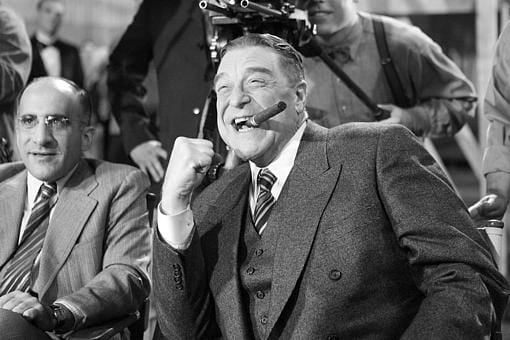By Meredith Alloway · November 28, 2011

I wasn’t sure what to expect when sitting down to see The Artist. The hype was huge. The Weinstein’s are behind it and banking on their contender reaping all the Oscar benefits. But it’s a silent film? I asked the same thing. The film proves, in both an ode to and reinvention of the 1920s Hollywood cinema, that you don’t need dialogue to tell a damn good story.
The film introduces us to a legendary star, George Valentin (Jean Dujardin). He can laugh, he can dance, his dogs can do clever tricks… but he can’t talk. Not in film at least. When his producer Al Zimmer, played with his usual comedic gravitas by John Goodman, shows George the new movement in cinema, he’s almost immediately mocked. George believes “talkies” are ridiculous. His pride and attempts to preserve his silent film fame continue to diminish his shot at ever being successful again. As Al tells him, “The public want young!” George is not.
But the real story in The Artist focuses on George’s love affair with Peppy Miller (Berenice Bejo). After meeting on the set of one of his films, George instantly falls for the wide-eyed, doting and delectable Peppy who hopes to be a star too someday. He gifts her with the trademark responsible for the success of her future career: a beauty mark.
We witness the years pass and how George and Peppy soar into polar opposite directions. Peppy is Hollywood’s latest it-girl and George is a nobody, a forgotten shooting star. Can George pull himself out of his debt and depression and overcome his crippling pride? Will Peppy forget about her once-admired star of the screen George? Will they end up together, or continue to unravel apart? The questions are cliché, but the plot is classic. We know what happens next, but we’re dying to see how.
Michel Hazanavicius, who wrote and directed the film, isn’t shy about his love for Hollywood noir. But what is unexpected, and cleverly disguised in the film’s marketing, is that The Artist is not a silent film. It’s not a replica of what’s been done before; instead, it’s a elegant compilation of the past and present. At times, it feels as if Chaplin could enter for a pas de deux with his pal George. A moment later, you wouldn’t be surprised if Adrian Brody joined in with George for some whisky wallowing at the local bar. The simple, charming jokes and Charleston trotting moments still ring true decades later. But the film finds foundation in modern cinema through the intimate look into the lives of the main characters and just how realistic the actors have chosen to be.
Bejo and Dujardin have mastered the delicate balance between naturalism and melodrama. Any stylization is grounded in the circumstances of their characters. George and Peppy live in the 1920s, and because each actor has developed a clear understanding of this world, the film exudes noir. This allows the glamour and peculiarity of silent cinema, that Hazanavicius is striving for in his film, to arise from his characters rather than his lens.
Some may have a problem with The Artist. But, it’s because they’re expecting one of two things (or maybe both): easy entertainment or genre accuracy. You can’t text or hunt for the last red sour patch kid in this one folks; you need your eyes at all times. And thank you Hazanavicius for treating your audience respectfully (it’s not often now that filmmakers assume their audience is intelligent.)
No, we don’t need captions for every sentence the actors speak. Lucky for us, these actors have accomplished the art of communicating with their face and not just with their dialogue. And No, this is not an accurate depiction of a 1920s silent film. There is a score, breathtaking at that, which accompanies the entire film and short moments of sound, illogical but deliciously edifying. The Weinsteins have done it again: found a film that braves the barriers and dares its audiences to witness something old, but delightfully new.